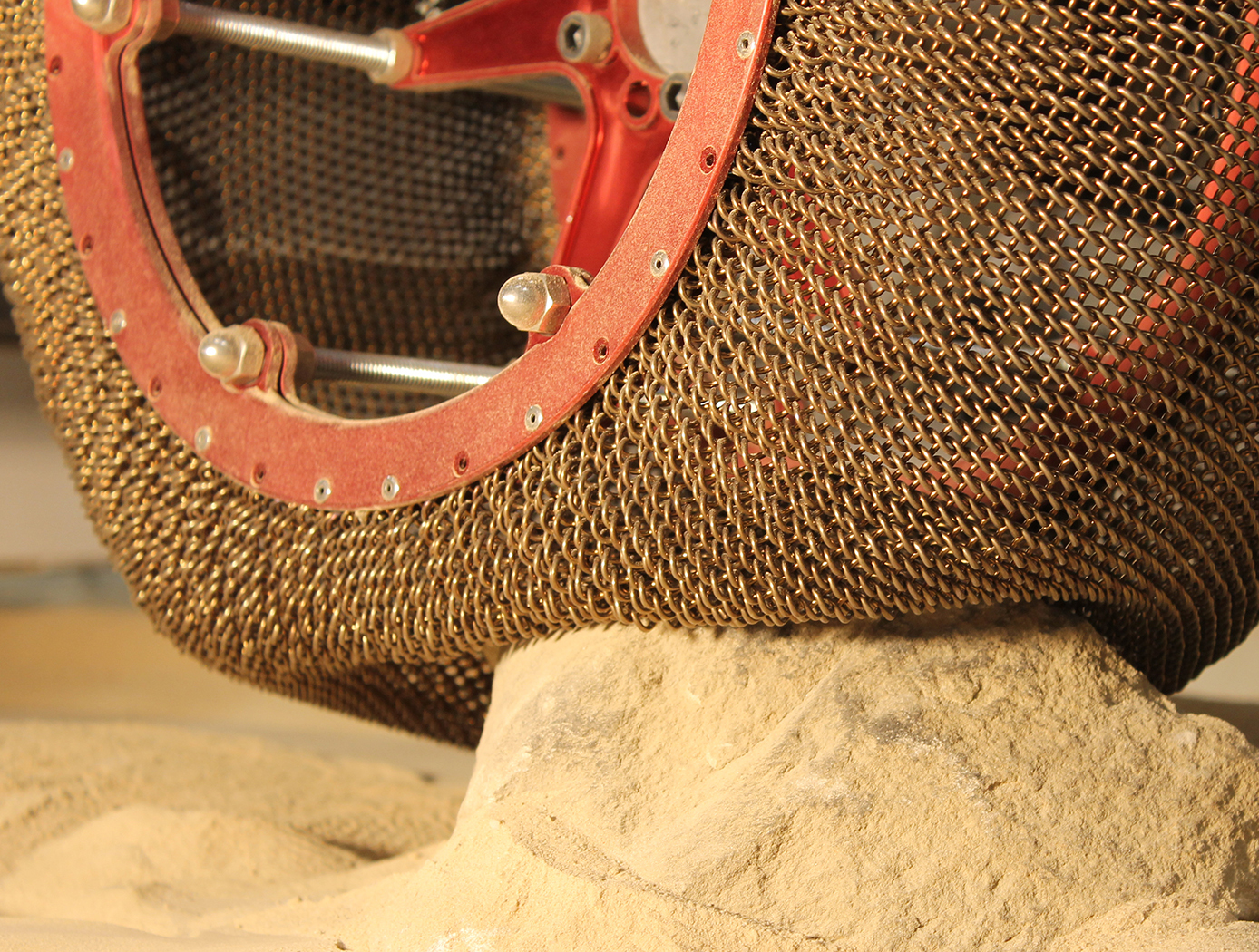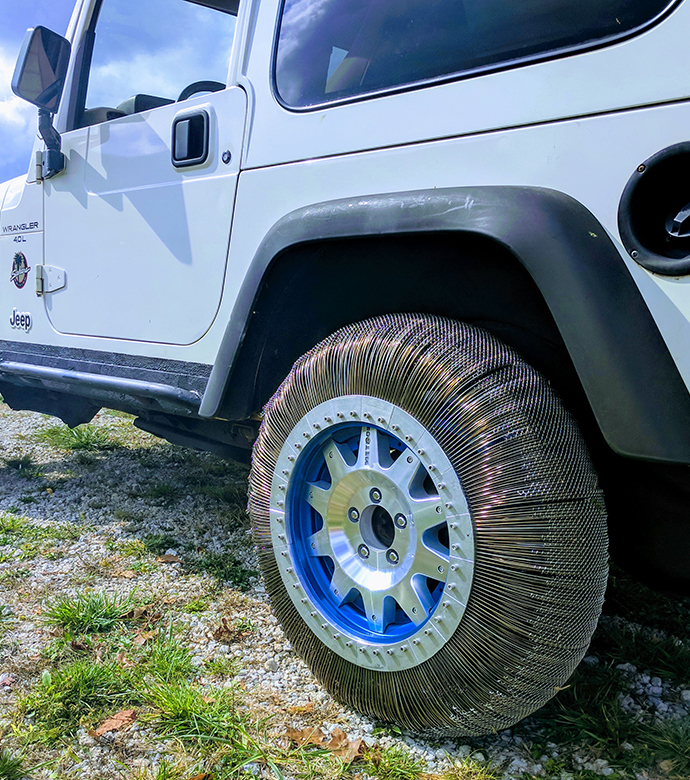Superelastic Tire
mechanical and fluid systems
Superelastic Tire (LEW-TOPS-99)
A viable alternative to the pneumatic tire
Overview
Innovators at NASA's Glenn Research center have developed a game changing, non-pneumatic, compliant tire. This innovation, called the Superelastic Tire, was developed for future Moon and Mars missions, but is a viable alternative to pneumatic tires here on Earth. This technology represents the latest evolution of the Spring Tire which was invented by NASA Glenn and Goodyear, and inspired by the Apollo lunar tires. The novel use of shape memory alloys capable of undergoing high strain as load bearing components, instead of typical elastic materials, results in a tire that can withstand excessive deformation without permanent damage. Using shape memory alloy as radial stiffening elements can also increase the load carrying capacity of the tire. The Superelastic Tire offers traction equal or superior to conventional pneumatic tires and eliminates both the possibility of puncture failures and running "under-inflated", thereby improving automobile fuel efficiency and safety. Also, this tire design does not require an inner frame which both simplifies and lightens the tire/wheel assembly.
The Technology
This NASA Glenn innovation comprises a non-pneumatic, compliant tire utilizing shape memory alloys (mainly NiTi and its derivatives) as load bearing components. These shape memory alloys are capable of undergoing significant reversible strain (up to 10%), enabling the tire to withstand an order of magnitude more deformation than other non-pneumatic tires before undergoing permanent deformation. Commonly used elastic-plastic materials (e.g. spring steels, composites, etc.) can only be subjected to strains on the order of ~ 0.3-0.5% before yielding. Hence, the use of a NiTi shape memory alloy produces a superelastic tire that is virtually impervious to plastic deformation. In addition, the utilization of shape memory alloys provides enhanced control over the effective stiffness as a function of the deformation, providing increased design versatility. For instance, the Glenn Superelastic Tire can be made to soften with increased deflection, reducing the amount of energy transferred to the vehicle during high deformation events. In addition, the use of shape memory alloys in the form of radial stiffeners, as opposed to springs, provides even more load carrying potential and improved design flexibility. This type of compliant tire would allow for increased travel speeds in off-road applications.


Benefits
- Safe: Eliminates the possibility of puncture failure
- Strong: Can withstand excessive deformation
- Robust: Can be configured for high traction on various terrains
- Simple: Eliminates the need for air
- Versatile: Tire stiffness can be designed to limit energy transferred to vehicle
- Lightweight: No inner frame needed for the tire/wheel assembly
Applications
- Automotive (trucking, all-terrain, commercial, automobile tires)
- Military (Improvised Explosive Device (IED), ballistic resistant tires)
- Industrial machinery (heavy-duty construction, agriculture tires)
- Aerospace
- High-performance sports
- Search and rescue
Technology Details
mechanical and fluid systems
LEW-TOPS-99
LEW-18729-1
LEW-19444-1
LEW-19444-2
Similar Results

Shape Memory Alloy Tubular Structure
The Glenn technology utilizes SMA structural elements (wires and springs) interlocked via a unique layering pattern, allowing the structure to take on tubular geometries while exhibiting the same ride performance as traditional tires. Though previous tires have used SMA elements as load-carrying members, this new design offers an improved structural pattern - consisting of two layers of SMA elements. The primary layer is a single wire shape set into a coil and wrapped circumferentially around a wheel, which sets the overall tire geometry and provides added strength in the radial and axial directions. The secondary layer consists of smaller SMA springs interlocked with each other as well as the primary coil, acting as a sheath that sets the coil spacing and provides the necessary shear stiffness.
SMAs are superelastic in nature and can take up to 8% effective reversible strain without yielding. The SMAs can handle up to 30x more strain, allowing the tire structure to undergo high levels of deformation without permanent damage. Because these tires do not rely on air, the risks associated with a flat tire are eliminated, and tire stiffness never varies (the tires never run 'under-inflated'). Furthermore, this airless tire design may enable the redesigning of wheel and braking systems. The first bicycle tire prototype was estimated to have a tire stiffness comparable to a road bike tire inflated to 75 psi, but with improved lateral and shear stiffness. By varying the SMA wire geometry, a wide range of tire sizes and stiffnesses is achievable. Rubber tread surfaces may be attached to the outside of the SMA tire for sufficient traction on a variety of terrain.

How to Train Shape Memory Alloys
Glenn researchers have optimized how shape memory alloys (SMAs) are trained by reconceptualizing the entire stabilization process. Whereas prior techniques stabilize SMAs during thermal cycling, under conditions of fixed stress (known as the isobaric response), what Glenn's innovators have done instead is to use mechanical cycling under conditions of fixed temperature (the isothermal response) to achieve stabilization rapidly and efficiently. This novel method uses the isobaric response to establish the stabilization point under conditions identical to those that will be used during service. Once the stabilization point is known, a set of isothermal mechanical cycling experiments is then performed using different levels of applied stress. Each of these mechanical cycling experiments is left to run until the strain response has stabilized. When the stress levels required to achieve stabilization under isothermal conditions are known, they can be used to train the material in a fraction of the time that would be required to train the material using only thermal cycling. As the strain state has been achieved isothermally, the material can be switched back under isobaric conditions, and will remain stabilized during service. In short, Glenn's method of training can be completed in a matter of minutes rather than in days or even weeks, and so SMAs become much more practical to use in a wide range of applications.
.jpg)
Shape Memory Alloy Mechanisms for CubeSats
Most spacecraft feature release, retention, and deployment devices as key components, because these devices achieve on-demand configurability of solar panels, probes, antennas, scientific instruments, fairings, etc. Until now, designing and using such devices in small spacecraft has been a challenge, because their mass, volume, and power requirements are significant and can impose design constraints. CubeSats, in particular, often need to deploy several structures (such as solar arrays) simultaneously, which prior-art deployment devices have not been able to manage effectively. Glenn's innovation embeds SMAs within the components so the structures can be retained during launch, then released and deployed in orbit. The release and retention device is controlled by an SMA activated pin puller to disengage the release plate from the hooks holding the solar arrays. Once released, the SMA hinge is passively enabled to the deployed state. When ready on orbit, the mechanism is commanded to release and electrical power is sent to the SMA actuator, releasing the component to its deployed state. The component is deployed to its final position through the use of hinges, which are activated passively with SMA spring strips. The retention and release device and hinge are substantially smaller and lighter than deployment mechanisms have ever been and can deploy simultaneously with great reliability. Having already been successfully deployed on a NASA mission, Glenn's innovation is a game-changing technology for CubeSats and other small satellites.

Shape Memory Alloy Rock Splitters (SMARS)
Glenn's revolutionary SMARS device is fabricated from nickel-titanium-halfnium (NiTiHf), nickel-titanium-zirconium compositions, or a combination. These compositions contain a secondary, nanometer-sized precipitate phase, which is produced through processes of compositional control and ageing heat treatments. Glenn's novel materials and processes have yielded a SMA composition that produces much higher stresses than other SMAs on the commercial market.
The SMARS device is composed of 1) SMA material as the actuating member; 2) a casing heater placed around the SMA member; 3) a DC or AC power source to provide current through the heater; 4) pointed tips for acute penetration into rock formations; and 5) a hand-press to reset the SMA element after each use. In the rock-splitting process, a hole equal to the diameter of the SMA element is drilled in the portion of the rock where the fracture is desired. Next, the pre-compressed SMA is inserted into the hole, and AC or DC current is applied to energize the devices heaters. Once the heater achieves the critical transformation temperature, the SMA will begin to expand within seconds. Since its expansion is constrained by the rock walls, the SMA will eventually exert up to 1500 MPa of stress, splitting the rock apart. When the current is removed and the heater cools, the SMA material returns to its pre-compressed state. At this point, the material can be recovered, so the process is repeatable after reshaping. The SMA actuating members were also designed to achieve displacement greater than the materials strain output. Glenns SMARS device provides high-powered rock fracturing that is controllable, reliable, and comparatively simple without the use of explosives, hydraulics, or chemicals.

Precipitation Strengthened
Ni-Ti-Pd Shape Memory Alloys
Shape memory alloys (SMAs) are metals that can return to their original shape following thermal input and are largely used as actuators for various applications across industries including space, aeronautics, automotive, and biomedical. These alloys can require long processing times to stabilize through repeated training cycles and suffer from loss of strength and stability during use. Precipitation strengthening (using heat treatments to grow small nanoscale regions of distinct metal phases within the base alloy) is one way to mitigate these issues.
The NASA inventors have combined a modification of typical NiTi compositions by introducing Palladium (Pd) and small amounts of other metals and specific heat treatments to produce a novel SMA with improved properties. Specifically, the alloy is inherently stable, reducing both the need for extended processing times to stabilize the metal and the possibility of failure during high numbers of actuation cycles. Further, the SMA is specifically designed to have significantly lower hysteresis (the temperature difference between the heating and cooling) than current state of the art SMAs, i.e., at or below 10°C compared to 20°C or above. These properties combine for a SMA with enhanced properties usable across various industries and applications for reliable actuation.
The related patent is now available to license. Please note that NASA does not manufacturer products itself for commercial sale.



